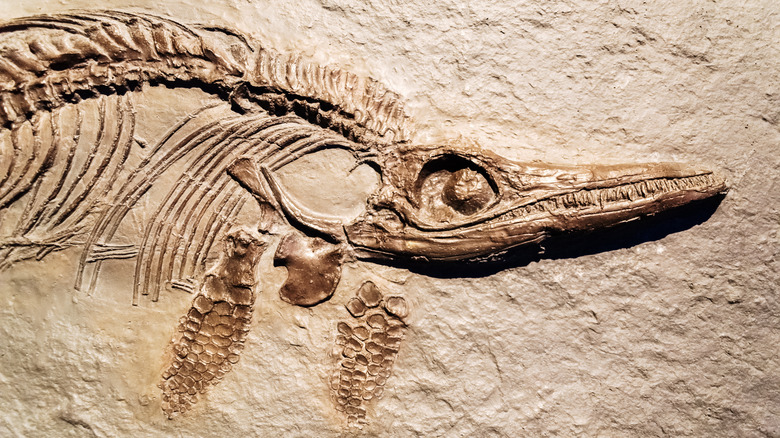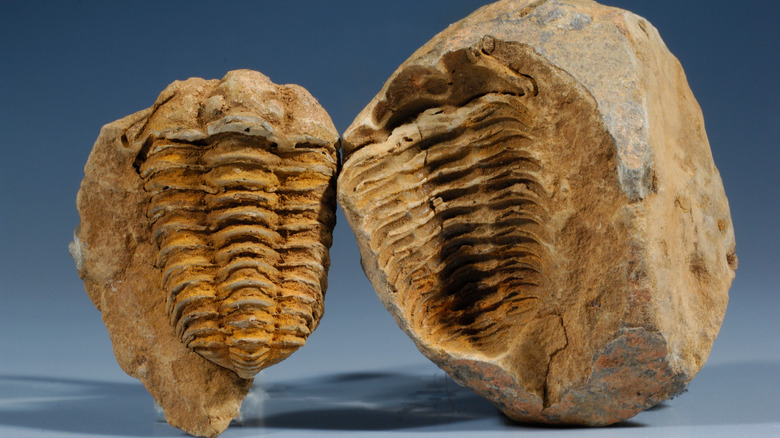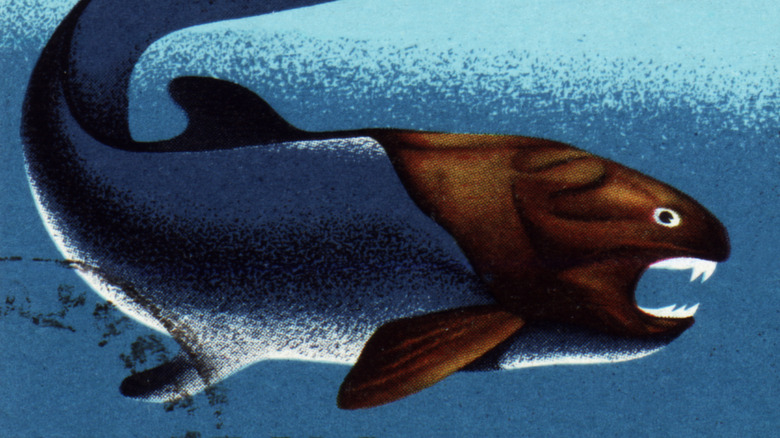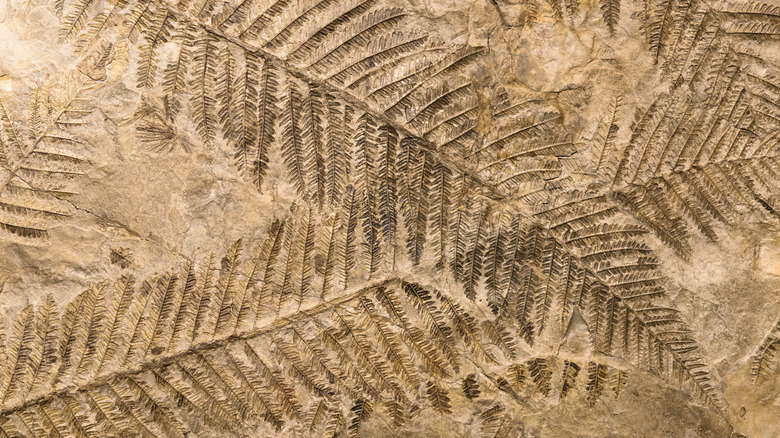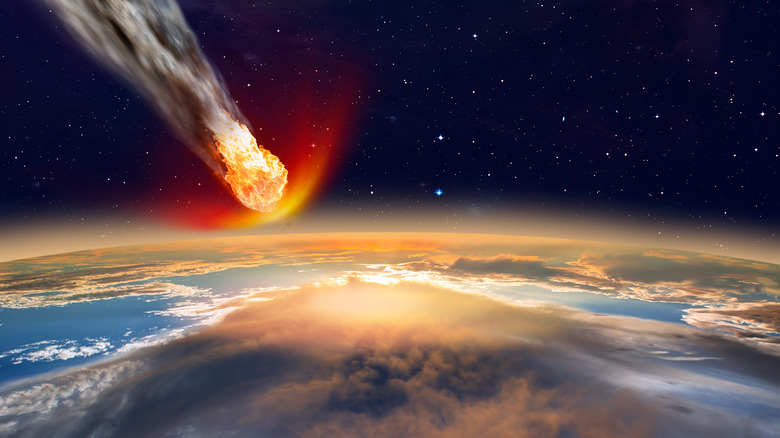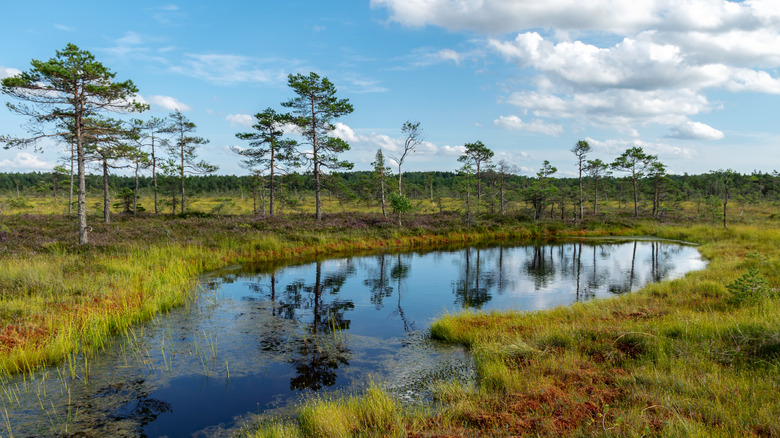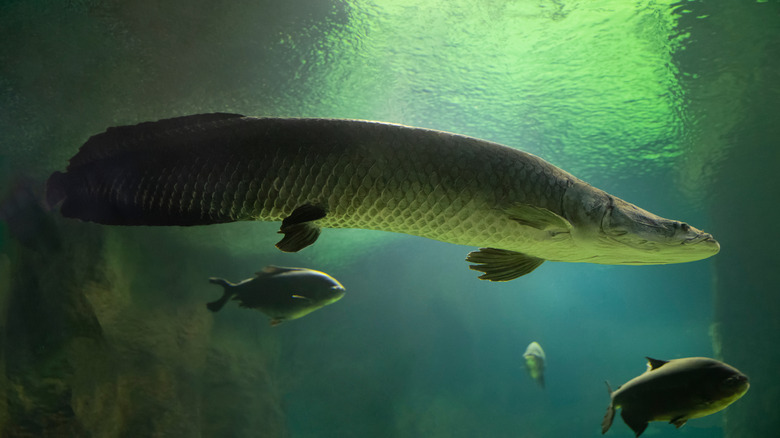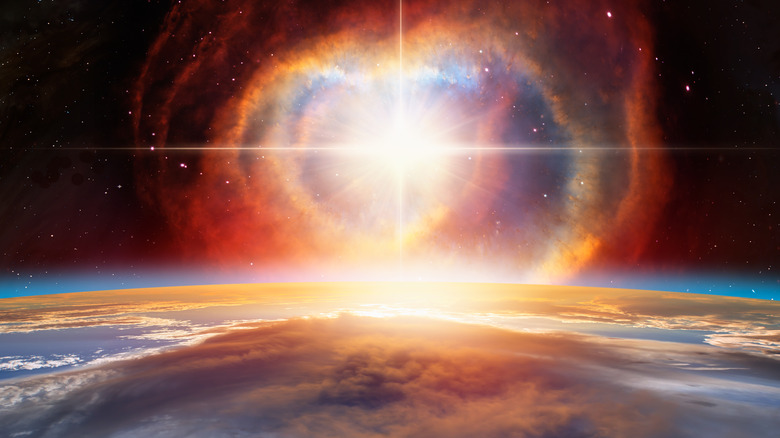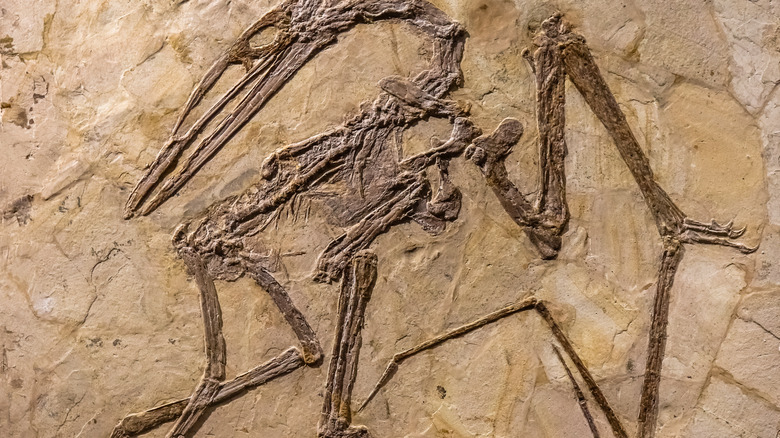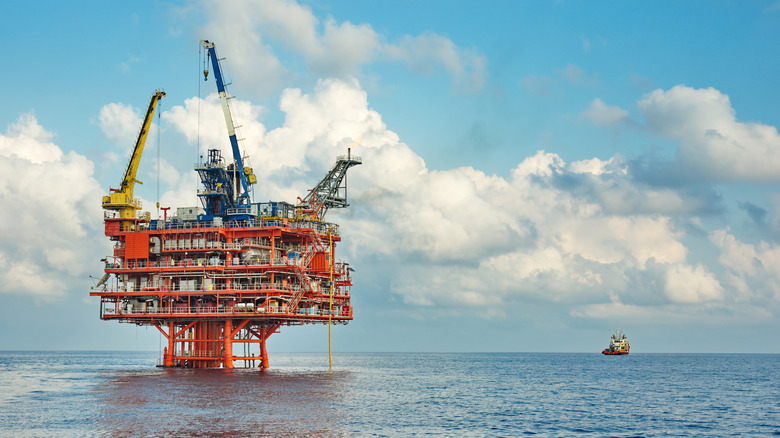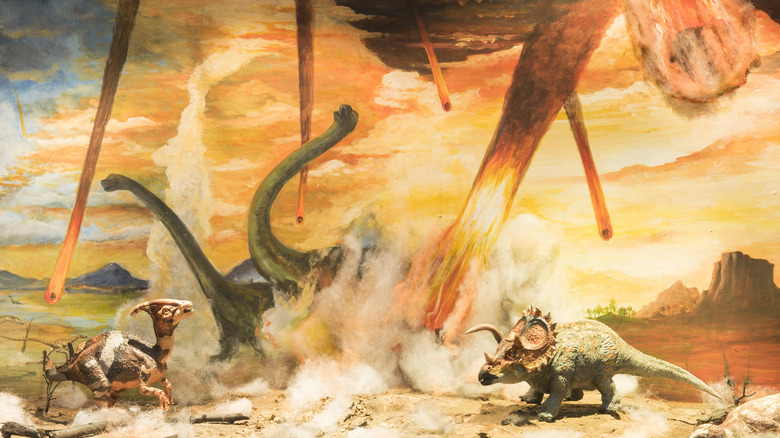The Tragic Truth About The Devonian Mass Extinction
The Devonian Period was an interval of the ancient Paleozoic Era spanning from about 419.2 million years ago to 358.9 million years ago, according to Britannica. (The greater Paleozoic Era lasted from 541 million years to 252 million years ago, before making way for the Mesozoic Era, the time of the dinosaurs.) In the 4.54 billion year history of Earth, the 60-million-year Devonian Period may be of modest significance, but its ramifications were huge.
The Devonian Period takes its name from Devon, England, thanks to rusty-colored sandstone rocks dating from that time period unearthed near the town. If you associate British geology more closely with the White Cliffs of Dover or the gray stones quarried to construct Stonehenge, that makes sense: Red sandstone really makes little sense in the context of current British terra firma. The thing is, the sandstone from the Devonian Period was "delivered" to the landmass that is now Great Britain courtesy of a temporary merger with the continent that is now North America, via National Geographic. A lot happened a long time ago. And for most of the living creatures of the so-called "Age of Fishes," a lot of it was bad.
But don't feel too badly for those Tiktaaliks, ammonoids, and others: the Devonian extinctions happened over the course of millions of years. Which is more than the few thousand years the dinosaurs likely got after the Chicxulub asteroid impacted what is now the Yucatan Peninsula some 66 million years back, via Live Science.
Up to 80% of all species and 20% of families were killed off
To start right off with some perspective on just how deadly the Devonian Mass Extinctions really were, just think of the number 80, specifically 80%. Because that's the potential number of species that died out during the extinctions, according to Britannica. To be clear, that's not to say that as much as 80% of the life on earth died, but that 80% of the very types of life disappeared forever. And even with the many species that we know died out, we have surely only identified a fraction of the total — many animal species are sure to have lived, collapsed, and disappeared forever.
As if that level of extinction weren't sobering enough, this can be added to the grim statistics: 20% of all animal families living on the planet went extinct during the Devonian Mass Extinctions. To elucidate, take a quick look at taxonomy, which, according to Oxford Languages, is "the branch of science concerned with classification, especially of organisms." From the top down, meaning all life on earth, plants, animals, bacteria, all of it, to the most distinct classification taxonomy can muster, the order goes: Domain Eukarya (that's every living thing), Kingdom Animalia (dogs, worms, spiders, humans, microscopic mites, all life that's not plants), Phylum, Class, Order, Family, Genus, and finally Species.
The fact that 20% of all animal Families died out is like losing not just a type or monkey or a breed of dog, but like losing all monkeys and apes writ large, or all dogs and dog-like animals completely.
The extinctions happened in phases
When you hear the words "mass extinction" you likely think at once of a sudden, cataclysmic event, such as happened when an asteroid struck the earth at the end of the Cretaceous Period. (The Mesozoic Era, the time of the dinosaurs, is broken into the Triassic, Jurassic, and Cretaceous Periods, chronologically — yes, there is a lot to keep in your heard when ordering things.) But the extinctions that occurred during the Devonian Period did not happen quickly, nor did they happen all at the same time.
There were actually four periods of elevated extinction that occurred within the span of those millions of years known largely as the Devonian Extinctions, and these are the Lower Zilchov, Taghanic, Kellwasser, and Hangenberg extinction events. According to Discover Magazine, the Kellwasser and Hangenberg events, which occurred in the middle and latter half of the period, respectively, were the deadliest parts of the period. Scientists have identified an impact crater in Sweden called the Siljan Ring, via Earth Observatory, that dates to near the start of the Kellwasser event (some 380 million years ago) which may suggest at least a partial cause of the die offs being the impact of a space object. And the Hangenberg event, coming in the latter part of the Devonian Period, was likely a result of changes to the entire climate and ecosystem of the globe that had occurred over the preceding stages.
As plant life thrived, animal life suffered
In a cruel twist of irony, many scientists think it's quite likely that the thriving of plant life led to the death of so much animal life, according to Sam Noble Museum. Strange as it is to think of life without plants, in fact, animal life was the first to emerge on planet Earth. According to the Smithsonian Museum of Natural History, animal life — at least in the form of "life" consisting of clusters of DNA — evolved around 800 million years ago. According to the Penn State Eberly College of Science, plants evolved on the planet approximately 700 million years ago, which is much earlier than previous estimates of around 480 million years ago, but still about 100 million years after animal life.
Regardless, plant and animal life lived in a good balance for many, many years. Until, it seems, they didn't. In the latter years of the Devonian Period, large trees emerged, as did lots of other terrestrial plant life, and they began to consume and trap more carbon dioxide. This meant less greenhouse gas in the air, which would have led to global cooling that, in time, created an earth inhospitable to many animal species. And to make matters worse, experts think that as plant life evolved and spread ever farther across the land, it likely disrupted many parts of the planet and released minerals once trapped in rocks, which spilled into the waters. This would have provided nutrients for algae blooms that would have sapped huge swaths of the water of oxygen the marine life needed (via Discover Magazine), meaning plant life was inadvertently killing off animal life from both above and below the surface.
There may have been multiple causes for the die-offs
There are quite a few possible causes of the Devonian Extinction — or rather the many extinction events of the Devonian Period. There may well have been a major asteroid strike that killed much of life quickly and even more catastrophic events over the ensuing millennia as a result of changes to the environment. The huge expansion of plant life on land almost surely contributed to much of the death that occurred under water as Earth simply became inhospitable to many animals in a long, slow process.
But there are also several other theories out there about things that contributed to the Devonian Extinctions, according to Discover Magazine. These include the impacts caused by a few major volcanic eruptions, for example. Volcanic activity could have changed the atmosphere above the Earth and thrown off the balance in the oceans (via Scientific Reports). Another theory is that a breakdown in portions of the ozone layer during the Devonian Period let in a surplus of ultraviolet light, and this dangerous solar radiation led to many of the planet's species dying out.
While we will never be certain of the exact causes of any of the several extinction events that make up the whole of the Devonian mass extinctions that occurred all those hundreds of millions of years ago, it's likely that at least some blending of these factors — and maybe others, too — led to all the death and collapse.
The extinctions may have been caused by a cooling or warming earth
Whether the changes were precipitated by the explosive growth of plant life, by volcanic activity, by impacts from asteroids that came hurling in from space, or by many factors combined together, ironically, the actual cause of much of the extinction during the Devonian Period was likely one of two things: global warming, or its opposite, global cooling, according to data from Miguasha National Park. As plants grew ever larger and spread more densely across the planet, they would have sequestered much more carbon dioxide, thus reducing greenhouse gasses in the air and causing the planet to cool. A period of glaciation and colder seas would have led to the collapse of many species that had evolved to thrive in specific conditions. (Asteroid strikes and volcanic eruptions could have further caused cooling by spewing materials into the air that reflected solar energy away from the surface of the earth.)
On the other hand, one or more of the extinction events may also have been triggered by the warming of the planet, according to Science. It's quite likely, based on geological evidence, that near the end of the Devonian Period, the planet was experiencing a global rise in temperature that led to a severe depletion of the ozone layer which would have let in excessive amounts of deadly UV radiation. Much of this ozone depletion would have been caused by ever more violent storms that the planet experiences during periods of global warming, (which should give species extant right now cause for a bit of nervousness).
Freshwater fish were almost untouched by the extinction events
While between 70% and 80% of all species on earth died out during the Devonian Period, the extinctions were hardly distributed evenly. Marine life living in the oceans were the hardest hit, while, according to Miguasha National Park, freshwater fish largely survived the period with their many different species intact. So too did the primitive animals already living on land make it through the Devonian Period largely intact, these including animals like the millipede, which was the first land animal, according to the Field Museum.
And in case you're wondering, millipedes and other arthropods emerged some 400 million years ago. They were joined on land by tetrapods years later, tetrapods resembling a mix of air-breathing fish like the mudskipper and amphibians like the salamander. These early animals (the tetrapods, not the arthropods, to be clear) are the ancestors for all the rest of the life on our planet, so it's a pretty good thing that they survived the Devonian Extinctions.
The final extinction event of the era may have been caused by a dying star
According to a report prepared by the National Academy of Sciences, there is one more possible cause for the final Devonian Extinction event that's a little less terrestrial in nature: the death of a nearby star. The researchers postulate that if a star in relative proximity to the earth had gone supernova — which is the supermassive explosion that occurs when a star's core finally collapses in the final throes of death — all the energy thrown off by the supernova explosion could have triggered massive die offs here on earth. That's because as all that energy bombarded the planet, it could have blasted away much of the earth's protective ozone layer.
And when the ozone layer is depleted, ultraviolet radiation comes pouring down on the planet, and that leads to lots of death down here. Though the supernova extinction event trigger is just a theory, it's a very plausible one, according to Astronomy.com — all that scientists need is to find particles with radioisotopes that can be dated to the right period of time, as these could reveal the exploding star as the destroyer of so much life.
The loss of so many marine animals set the stage for evolution
You know the expression about nature abhorring a vacuum? Well, it does, if the events following the Devonian Extinction are any proof. In the aftermath of the extinction event that primarily impacted marine life, two things happened: first, animal life on land began to diversify and thrive, and then, ironically, new species of marine animals evolved and thrived in those very waters recently cleared of so many animals.
According to Discover Magazine, because the remaining animals living in the seas found themselves with so much less competition, they could evolve and spread more rapidly than ever. The ancient ancestors of bony fish and cartilaginous fish (fish with bodies primarily supported by cartilage, like sharks and rays, that is to say) that are still alive today found themselves as the top dogs, so to speak, in those ancient waters.
Now, to be clear, there is a chance that these species — those that evolved from the ones that survived — were always going to dominate in time and that the Devonian die offs only accelerated things. Either way, they were the survivors in the waters. And on land, those tetrapods, "grotesque amphibians slumping around in swamps" as University of Chicago biologist Michael Coates has called them, thrived and diversified into a plethora of species.
Much of the oil extracted today comes from Devonian-era sources
According to Geo Science World, a huge amount of the oil and natural gas extracted from the planet comes to us from Devonian-era deposits. Meaning it is made from the long leftover slurry created by all that death so many millions of years ago. While people often think of oil and gas as being dinosaur goo, much or even more of it is likely ancient fish.
The fossil fuels used today — which maybe shouldn't be used quite as much, because they won't be replaced any time soon — are a mix of animal life as well as decayed and pressurized plant life and algae that turned into oil, gas, and coal, according to National Geographic. How ironic, really, that the fuels burned up today are so horribly contributing to a warming planet that is in turn killing off species and may well lead to a bona fide extinction event in coming years, with said fuel being largely derived from animals that were themselves killed off in mass extinction events.
The Devonian Mass Extinction was but one of five such global catastrophes so far
To make one thing clear, according to the British Natural History Museum, "a mass extinction event is when species vanish much faster than they are replaced." Given the 70% to 80% species die off during the Devonian, that is indeed a mass extinction if ever there was one. But there wasn't one: so far, there have been five. And as shocking as this might sound, all things considered, the Devonian Extinctions were hardly the worst. First came the Ordovician-Silurian mass extinction, which occurred about 443 million years ago and eliminated approximately 85% of all species. Experts think it was caused by a plunge in temperatures worldwide which led to glaciation and falling sea levels. The second was the Devonian.
Third came the Permian mass extinction, which happened right at the dawn of the age of dinosaurs, some 250 million years ago, and was the largest and most devastating of all five of the die offs. A staggering 95% of all species on the planet went lights out for good. The Permian extinctions seem to have been caused by a cataclysmic event, either a huge asteroid strike or mighty volcanic activity — either way, the entire atmosphere was impacted and death reigned. The Triassic mass extinction event happened some 200 million years ago and killed a portion of species similar to that which died during the Devonian, aka 80% of all extant species.
And finally came the Cretaceous mass extinction event 65 million years ago, which caused the death of about 78% of all species, including all dinosaurs, save the few who evolved into modern birds, and paved the way for the time of mammals.
